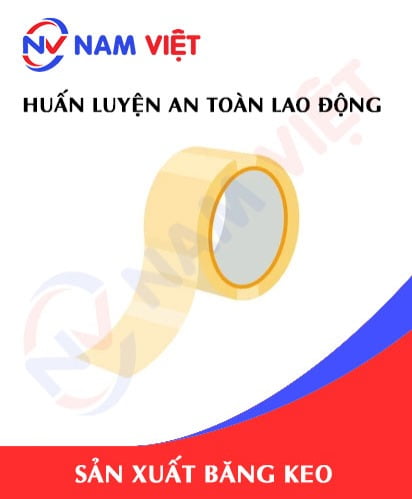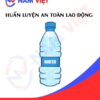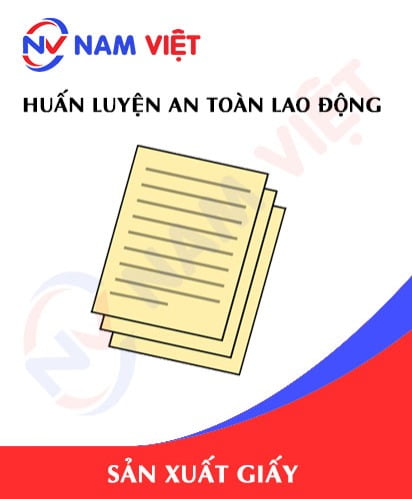Occupational safety training for tape manufacturing
99,000 ₫
Note: The above price is calculated per person, the price may vary depending on the number of trainees participating in the course and market fluctuations. For more accurate pricing support, please refer to the quotation or contact our consultants directly.
Occupational safety is an important issue in tape manufacturing factories and needs to be addressed promptly to ensure the health and safety of workers, and enhance the reputation of businesses. The Occupational Safety Training course is one of the effective solutions to raise awareness about how to prevent workplace accidents for workers participating in tape manufacturing.
Table of Contents
Toggle1. Overview of tape
a. What is tape?
- Tape is a type of material used to adhere items, surfaces, or packaging together. Tape is usually made with a layer of adhesive on one side and a layer of material such as paper, plastic, or fabric on the other.
- Tape is widely used in various industries, especially in packaging and transporting goods. It’s also used in other applications like making surfaces smoother or protecting surfaces from dust and damage. There are many types of tape with different properties and features suitable for each purpose, such as packaging tape, masking tape, glass tape, cloth tape, etc.
- According to a report by the Vietnam Customs Department, the volume of tape imported into Vietnam has grown strongly in recent years. This shows that the demand for tape from consumers and businesses in Vietnam is increasing.
- However, there are still many challenges for the tape manufacturing industry in Vietnam, including competition from foreign tape manufacturers, the need for advanced manufacturing technology, and high initial investment costs. Some businesses are also facing issues related to product quality and the consumer market.

b. Types of machinery for tape manufacturing
Common types of machinery for tape manufacturing include:
- Manual tape dispenser: This is the most basic type of tape dispenser, used by hand to pull the tape and apply it to the desired surface.
- Semi-automatic tape dispenser: This is a type of tape dispenser that can automatically take tape from a roll, cut it to the desired length, and apply it to the desired surface. It is often used in mass manufacturing factories or large tape manufacturing companies.
- Tape manufacturing machine: This is a specialized machine for manufacturing tape from raw materials such as BOPP film, adhesive, and other additives. Tape manufacturing machines can be customized to produce different types of tape with different widths and thicknesses.
- Tape calendering machine: This is a type of machine used to calender tape, creating a thin and uniform layer on the tape’s surface, which helps increase the tape’s adhesion and prevents it from slipping when applied to a surface.
- Tape cutting machine: This is a type of machine used to cut tape into different lengths. Tape cutting machines can be customized to cut different types of tape with different widths and thicknesses.

c. Typical tape manufacturing enterprises
Currently, Vietnam has many tape manufacturing enterprises, among which some typical ones can be mentioned such as:
- Thai Binh Tape Co., Ltd.
- Dai Viet Tape Co., Ltd.
- Hanoi Tape Manufacturing and Trading Co., Ltd.
- Hung Thinh Tape Manufacturing Co., Ltd.
In addition, there are many other businesses such as Viet Nhat Tape Co., Ltd., Minh Tan Tape Co., Ltd., Nam Thanh Tape Co., Ltd., etc., also operating in the field of tape manufacturing in Vietnam.
d. Common types of tape on the market
There are many different types of tape on the market with different properties and applications. Below are some common types of tape:
- Paper tape: a type of tape used for packaging, sealing, carton sealing, and packing goods with medium adhesion.
- Silver tape: has a silver surface and high adhesion, used to protect metal and glass surfaces, and to create borders for advertising products.
- Film tape: a type of tape with a transparent film, high adhesion, often used to adhere small products, such as toys, electronic products, circuit boards, etc.
- Double-sided tape: tape with double-sided adhesion, often used to adhere decorative items, advertisements, and notes.
- PVC packaging tape: made of PVC plastic and has high adhesion, often used for packaging goods in humid and high-temperature environments.
- Protective tape: made from materials such as paper, plastic, PE, and used to protect surfaces from scratches or damage.
- Flexible tape: a flexible tape with high adhesion, often used to adhere toy products, electronic products, circuit boards, etc.
e. Specific jobs in a tape manufacturing factory
Group 1
- Executive director, deputy executive director, department manager in a tape manufacturing factory.
Group 2
- Safety officer: manages safety in the factory, designs safety procedures, supervises and urges employees to comply with safe work procedures.
Group 3
- Raw material preparation: Fabric, adhesive, and necessary chemicals and dyes are prepared and put into the manufacturing process.
- Adhesive and chemical mixing: Chemicals are mixed into the adhesive to create special properties for the product. This process is carried out using adhesive mixing machines.
- Tape fabric creation: Cotton fabric is processed to create the necessary thickness, softness, and durability for the product. Then, the adhesive is applied to the surface of the cotton fabric and cut into small rolls.
- Printing and packaging: The tape rolls are printed with necessary information such as product name, contact information, images, etc. Then, the tape is cut and packaged into small rolls for sale on the market.
- Quality control: The tape is quality controlled and ensured that it meets the necessary quality and safety standards.
- Machinery operation and maintenance: The tape manufacturing machinery needs to be operated and maintained regularly to ensure its performance and lifespan.
Group 4
- Jobs in the office, service, sales, marketing.
- Manufacturing management, quality management, human resource management, material management, financial accounting management.
- Research and development of new products, design of packaging and product models.

2. Overview of occupational safety training course for tape manufacturing
In this article, we focus on issues related to Group 3, because Group 3 is the group that directly participates in the manufacturing process and bears the highest risk of occupational accidents. Refer to other groups here
a. What is Group 3 occupational safety training?
- Occupational safety training for Group 3 are training sessions that equip workers with awareness of how to prevent occupational accidents.
- The occupational safety training course will help workers recognize and avoid dangers, limiting the risk of occupational accidents while working.
REGISTER FOR OCCUPATIONAL SAFETY TRAINING SERVICE
b. Training duration
Initial safety training duration
- Total training duration is at least 24 hours, including examination time.
- 8 hours of theoretical study on the system of policies and laws on occupational safety and health
- 8 hours of theoretical study on basic knowledge of occupational safety and health
- 4 hours of theoretical study on specialized training content
- 2 hours of practical study on specialized training content
- 2 hours of theoretical examination at the end of the training course
The safety training center will distribute the time into multiple training sessions depending on the time arrangement for employees. But usually, there will be 6 training sessions, and the course will take place over 3 days, on the condition that the manufacturing enterprise can arrange continuous study time.
Periodic safety training duration
- Before the occupational safety card expires, if an employee wants to have it reissued, they must undergo a periodic occupational safety training course, with the periodic safety training duration being at least 50% of the initial safety training duration.
Explanation: The total periodic occupational safety training duration is at least 12 hours, including examination time. After completing the periodic training course and passing the exam, the employee will be re-issued or have their occupational safety card renewed.
c. Content of the training course
| No. | TRAINING CONTENT | TRAINING DURATION (HOURS) | |||
| Total | Of which | ||||
| Theory | Practice | Exam | |||
| I | System of policies and laws on occupational safety and health | 8 | 8 | 0 | 0 |
| 1 | Overview of the system of legal documents on occupational safety and health. | 6 | 6 | ||
| 2 | System of technical standards and regulations on occupational safety and health. | 1 | 1 | ||
| 3 | Specific regulations of state management agencies on occupational safety and health when building new, expanding, or renovating works, facilities for manufacturing, using, preserving, storing, and inspecting machinery, equipment, materials, and substances with strict requirements on occupational safety and health. | 1 | 1 | ||
| II | Basic knowledge of occupational safety and health | 8 | 8 | 0 | 0 |
| 1 | Basic knowledge of dangerous and harmful factors in the workplace. | 4 | 4 | ||
| 2 | Methods for improving working conditions. | 1 | 1 | ||
| 3 | Safety culture in manufacturing and business. | 1 | 1 | ||
| 4 | Rights and obligations of employers and employees; policies and regimes on occupational safety and health for employees; functions and tasks of the network of occupational safety and health officers. | 1 | 1 | ||
| 5 | Occupational safety and health rules, signs, and instructions for occupational safety and health and the use of safety equipment, personal protective equipment; professional skills, first aid for occupational accidents, and prevention of occupational diseases. | 1 | 1 | ||
| III | Specialized training content | 6 | 4 | 2 | 0 |
| General knowledge of types of machinery, equipment, and substances that generate dangerous and harmful factors; analysis, assessment, and management of occupational safety and health risks, safe working procedures with machinery, equipment, and substances with strict requirements on occupational safety and health. | 6 | 4 | 2 | ||
| IV | Examination of occupational safety training content at the end of the training course | 2 | 2 | 0 | 0 |
| Total | 24 | 22 | 2 | ||
See more training content for 6 groups
d. Occupational safety card
After completing the occupational safety training course and passing the exam, the employee will be issued an occupational safety card (commonly referred to as a Group 3 occupational safety certificate ).
The Group 3 safety card will clearly show information such as: full name, date of birth, job, and specific working environment. It also includes the training duration, a red stamp, and a signature confirming the completion of the training course.
According to the regulations on issuing safety cards specified in Clause 2 of Article 24 of Decree 44/2016/ND-CP, there are two cases:
- If the employer and the employee have a labor contract, the employer must sign, stamp, and seal the safety card for the Group 3 trainee after they complete the training course from the occupational safety training unit and pass the exam.
- If the employee is a freelancer, seasonal worker, and does not have a labor contract, the training unit must sign, stamp, and seal the safety card for the employee after they complete the training course from the occupational safety training unit and pass the exam.

3. Identifying hazards in tape manufacturing
During the tape manufacturing process, some hazards can occur as follows:
- Since the tape manufacturing process often uses high temperatures and pressures, strict control of electrical safety and fire and explosion safety is necessary.
- During the tape manufacturing process, chemicals can be toxic to humans, so it’s essential to ensure safety in the use, storage, and handling of chemicals.
- The operation of machinery and use of related equipment in the tape manufacturing process can cause serious occupational accidents, such as cuts, burns, or being crushed.
- During the tape manufacturing process, some waste can cause environmental pollution, so it’s necessary to ensure that waste treatment procedures are in place and that waste is disposed of safely.
- Long-term exposure to chemicals and dust during the tape manufacturing process can cause many health problems for workers, such as respiratory diseases, allergies, and dermatitis.
4. Common occupational accidents in tape manufacturing
Common types of occupational accidents during the tape manufacturing process include:
- Cuts to hands, fingers, or other cuts when working with knives or tape cutting machines.
- Burns when working with tape manufacturing machinery or when handling materials like adhesive.
- Poisoning from inhaling vapors or chemicals during the manufacturing process.
- Injuries when transporting or installing rolls of tape.
- Accidents due to slipping, falling, or colliding with equipment or objects in the manufacturing factory.
5. Safety measures when participating in tape manufacturing
To ensure the safety of workers during the tape manufacturing process, the following measures can be applied:
- Employees need to be provided with protective equipment such as hard hats, safety glasses, gloves, safety shoes, anti-static jackets, masks, and other protective equipment to protect their health and safety.
- All employees need to be trained in occupational safety on occupational safety procedures, labor protection regulations, and related legal regulations on occupational safety. In particular, those who work directly with machinery need to be trained to use the machines safely and prevent occupational accidents.
- Machinery and equipment in the factory need to be maintained and inspected periodically to ensure they are working well and are safe. If any equipment is found to be damaged or not working correctly, it needs to be repaired or replaced in a timely manner.
- The tape manufacturing factory needs to be kept clean and hygienic to avoid the risk of occupational accidents due to an unsafe environment.
- Tape often doesn’t work well in humid environments, so the manufacturing environment needs to be controlled to avoid occupational safety risks.
- Tape manufacturers need to perform periodic quality control to ensure that the tape produced meets customer requirements for quality and durability. Low-quality tape products can lead to occupational accidents during transportation and use.
- Periodically organize work environment monitoring in manufacturing factories and enterprises, collect and analyze harmful factors to workers, and then adjust to reduce the level of harm to prevent occupational diseases for them.

6. Benefits of occupational safety training for tape manufacturing
An Toan Nam Viet provides businesses with excellent benefits after completing occupational safety training courses as regulated in Decree 44/2016/ND – CP on occupational safety and health, for companies, enterprises, and factories.
- Employees can recognize the potential risks of occupational accidents and then have preventive measures to avoid them.
- Your business can establish risk prevention measures in the manufacturing, operation, and maintenance processes.
- Reduce costs when safety risks occur in the workplace.
- Uninterrupted manufacturing will help increase labor productivity and product quality.
- Comply with occupational safety laws, avoiding legal risks.
- Create a reputation and professionalism in all aspects, thereby elevating your business’s brand.
Nam Viet’s training courses are a solution to prevent and combat external factors affecting individuals so they can avoid dangers that can lead to injury or, more seriously, death.
REGISTER FOR OCCUPATIONAL SAFETY TRAINING SERVICE
7. Customer feedback after completing the occupational safety training course for tape manufacturing
An Toan Nam Viet has many years of experience in its mission to accompany many businesses in Vietnam in general and in the southern provinces in particular. And that responsibility is something very valuable to Nam Viet, which is why our Occupational Safety Training is increasingly professional. And the motivation for An Toan Nam Viet’s strong development comes from the positive feedback and suggestions from the businesses we have served. Below are the testimonials from our valued partners.
Bac Nam E&C Investment and Construction Joint Stock Company
“The first time I used the service at An Toan Nam Viet, I was very surprised by the enthusiastic 24/7 support from the consulting team. The class organization was very quick and convenient for our company, thank you very much for Nam Viet’s service!”
Hoa Dat Construction and Trading Joint Stock Company
“Nam Viet’s service has helped us a lot in simplifying occupational safety and completing safety records for our work process. The consulting team is enthusiastic and timely in answering our questions. 5 stars for Nam Viet.”
See more customer interviews after using An Toan Nam Viet’s service
8. An Toan Nam Viet’s occupational safety training capability
An Toan Nam Viet is a reputable and high-quality occupational safety training center in Vietnam today. With continuous occupational safety training sessions taking place at manufacturing workshops, factories, or construction sites across the country (all 63 provinces and cities in Vietnam).
REGISTER FOR OCCUPATIONAL SAFETY TRAINING SERVICE
Occupational safety training license
- An Toan Nam Viet has been inspected and certified by the Safety Bureau of the Ministry of Labor – Invalids and Social Affairs as qualified to operate occupational safety and health training. This further strengthens our capacity in occupational safety training.

Training materials and lectures
- Before occupational safety training materials are used in occupational safety training courses, they are reviewed and approved to ensure that the lectures are factually correct and effective when applied.
- The teaching method of our instructors is standardized according to An Toan Nam Viet‘s teaching standards, which is a method that experts in occupational safety and health training have researched and refined during their teaching to bring the highest knowledge absorption efficiency to trainees.
Facilities
- Controlling the factors in the classroom that affect the training process will increase teaching performance and the effectiveness of student knowledge absorption.
- Our training support facilities always provide spacious classrooms that meet standards for area, lighting, training equipment, etc.
9. Reputable and quality nationwide safety training center
At An Toan Nam Viet, we always prioritize our professional dedication to occupational safety training. For us, imparting the knowledge of self-protection to workers so they have a safe foundation on their livelihood path is contributing to building the country.
To ensure effective training, we meticulously and carefully prepare every small detail. From preparing teaching tools, equipment, and devices to textbooks, materials, sound, and lighting.
Our occupational safety training instructors are experts with many years of experience in the field. They even have research projects identifying dangers in all occupations and how to prevent them.
The instructors’ lectures are distilled from real-world practice and are conveyed in the most vivid and easy-to-visualize way for workers. These factors help workers feel comfortable during their study time and absorb our taught knowledge well. Of course, the knowledge conveyed always closely follows Decree 44/2016/ND-CP.
From there, they grasp many measures to prevent dangers and how to protect themselves. At the same time, they can apply it in the most appropriate way in their actual work.
Our safety training center is proud to be a reputable and professional provider of occupational safety training services with the following advantages:
- Competitive training costs but training quality is still guaranteed.
- Lich organized training is flexible with the production situation of the company.
- Fast and legally compliant procedures for issuing occupational safety training certificates.
- Training instructors are highly experienced professionals with many years in the field.
- The classroom environment is controlled for factors that affect the training process, increasing teaching efficiency and student knowledge absorption.
- The lectures are compiled to be suitable for occupational safety work at businesses.
- An Toan Nam Viet works with dedication and professionalism to support customers accurately and as quickly as possible.

10. Additional reference materials for occupational safety training in tape manufacturing
- Occupational safety training materials for tape manufacturing
- Set of occupational safety training materials
- Set of occupational safety training test questions
- Multiple-choice occupational safety test for tape manufacturing
- Slides for occupational safety training lecture on tape manufacturing
1 review for Occupational safety training for tape manufacturing
No comments yet















namchinh.haiphong341
Dịch vụ ok nha